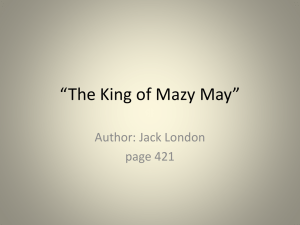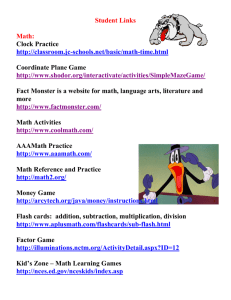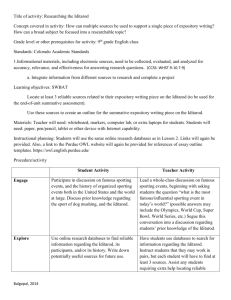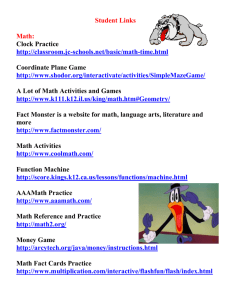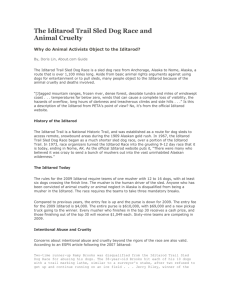Woodsong Unit
advertisement
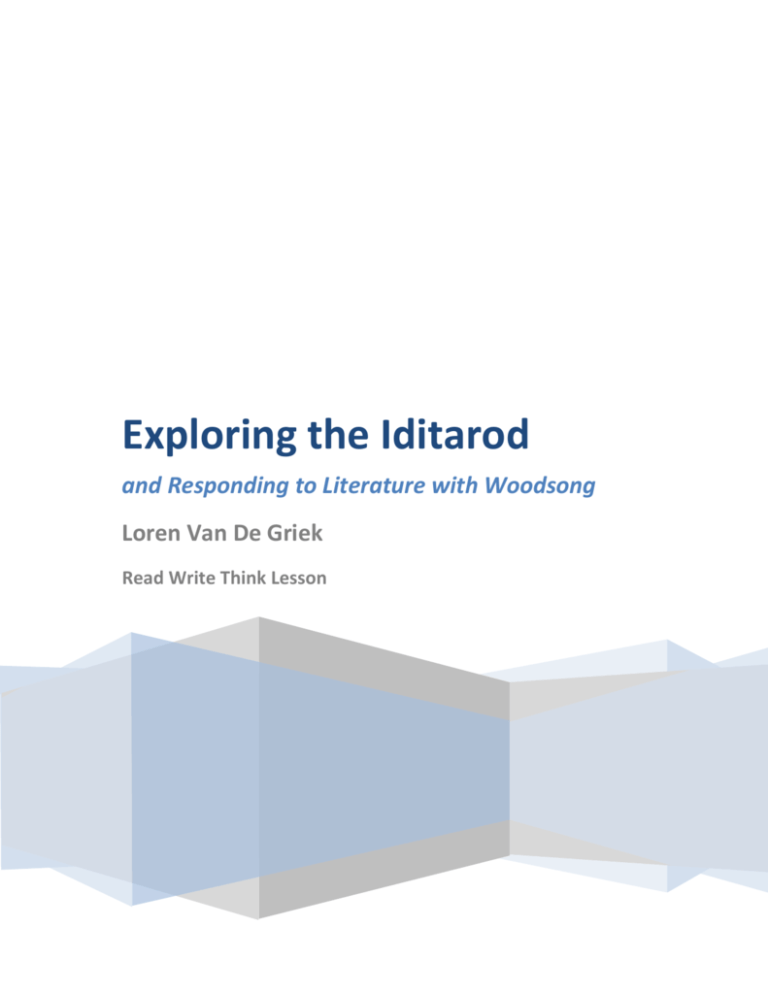
Exploring the Iditarod and Responding to Literature with Woodsong Loren Van De Griek Read Write Think Lesson Exploring the Iditarod Loren Van De Griek Lesson Exploring the Iditarod and Responding to Literature with Woodsong Estimated Time – 8 sessions @ 45 min – 1 hour each Grade 6 – 8 Standards NCTE/IRA National Standards for the English Language Arts 1. Students read a wide range of print and nonprint texts to build an understanding of texts, of themselves, and of the cultures of the United States and the world; to acquire new information; to respond to the needs and demands of society and the workplace; and for personal fulfillment. Among these texts are fiction and nonfiction, classic and contemporary works. 2. Students read a wide range of literature from many periods in many genres to build an understanding of the many dimensions (e.g., philosophical, ethical, aesthetic) of human experience. 3. Students apply a wide range of strategies to comprehend, interpret, evaluate, and appreciate texts. They draw on their prior experience, their interactions with other readers and writers, their knowledge of word meaning and of other texts, their word identification strategies, and their understanding of textual features (e.g., sound–letter correspondence, sentence structure, context, graphics). 4. Students adjust their use of spoken, written, and visual language (e.g., conventions, style, vocabulary) to communicate effectively with a variety of audiences and for different purposes. 11. Students participate as knowledgeable, reflective, creative, and critical members of a variety of literacy communities. 12. Students use spoken, written, and visual language to accomplish their own purposes (e.g., for learning, enjoyment, persuasion, and the exchange of information). NC Standards 1.05 Read independently daily from self-selected materials (consistent with the student's independent reading level) to: increase fluency. build background knowledge. expand and refine vocabulary. 2.02 Interact with the text before, during, and after reading, listening, and viewing by: making predictions. formulating questions. 2 Exploring the Iditarod supporting answers from textual information, previous experience, and/or other sources. drawing on personal, literary, and cultural understandings. seeking additional information. making connections with previous experiences, information, and ideas. 2.05 Evaluate inferences, conclusions, and generalizations and provide evidence by referencing the text(s). Abstract While following the Iditarod race, from Anchorage to Nome, Alaska, students will use comprehension strategies to become more experienced readers as they read and respond to Gary Paulsen’s Woodsong. Overview In a small group (13 – 15 students) setting, students will learn new vocabulary, read independently, discuss, and respond to Woodsong along with following the Iditarod race. Students will demonstrate their comprehension of the autobiography by using their prior knowledge to make predictions and connections. They will draw conclusions based on details from the story and make comparisons as well as find differences using details and make inferences. This lesson makes vast use of the strategies students need in order for them to delve deeper into a book. From Theory to Practice Experienced readers use specific strategies while reading in order to understand the texts they read. When teachers include response activities along with comprehension strategies in their instruction, students will become more aware of their own strategic reading. Lauren Aimonette Liang and Lee Galda explain how predicting is an integral part of responding to literature. This lesson is designed to remind students to use their predicting strategy and responding techniques every time they read whether inside or outside of class. Aimonette Liang, L, & Galda, L. (2009). Responding and comprehending: reading with delight and understanding [The Reading Teacher, 63(4) pp. 330-333]. (PDF), Retrieved from http://www.reading.org/Publish.aspx?page=RT-63-4Liang.html&mode=retrieve&D=10.1598/RT.63.4.9&F=RT-63-4-Liang.html&key=48F48120-B404-4039B9FF-F12FCBD57E5E# Reading is strategic. Reading is thinking. Therefore, comprehension means that readers have to think not only about what they are reading but about what they are learning as well. Stephanie Harvey and Anne Goudvis say that when readers construct meaning they are building their store of knowledge and they are doing this by activating their prior knowledge and making connections, by questioning, by making inferences, and by determining what is important. Harvey, S., & Goudvis, A. (2007). Strategies that work second edition teaching comprehension for understanding and engagement. Portland, ME: Stenhouse Publishers. 3 Exploring the Iditarod Student Objectives Students will: 1. learn a variety of new vocabulary words 2. improve comprehension by responding to an assortment of strategic questions by: a. accessing prior knowledge & making predictions b. drawing conclusions c. making inferences d. making personal connections e. comparing and contrasting 3. improve comprehension by reading and discussing the story 4. analyze the main character (Gary Paulsen) 5. learn about the Iditarod race Instructional Plan Resources Materials: Woodsong by Gary Paulsen Chart paper & markers Students’ response journals (optional) Activeboard (optional) Student Interactives: Biocube http://www.readwritethink.org/files/resources/interactives/bio_cube/ Bio-cube planning sheet http://www.readwritethink.org/files/resources/interactives/bio_cube/biocube_planning.pdf Websites: Gary Paulsen (http://www.randomhouse.com/features/garypaulsen/) The official site of the Iditarod Race (http://www.iditarod.com/) Carol Hurst (http://www.carolhurst.com/titles/woodsong.htm) Printouts: Anticipation Guide Chapters 1 & 2 vocabulary words and response questions 4 Exploring the Iditarod Chapters 3 & 4 vocabulary words and response questions Chapters 5 & 6 vocabulary words and response questions Chapters 7 & 8 vocabulary words and response questions Days 1 – 6 vocabulary words and response questions Days 7 – 17 vocabulary words and response questions Tests to go along with above Character Traits Bio-Cube Planning Sheet Preparation 1. IMPORTANT – the Iditarod Race officially starts the 1st Saturday in March, so if you want to do this unit in conjunction with the race be aware 2. Familiarize yourself with Woodsong by Gary Paulsen. Read Carol Hurst’s review, because the student’s will make their predictions based on this. Each student will need a copy of this book. I feel it is best to do this unit with a small to medium size group (no more than 15 students). For background information about the author, including his journal entries from when he ran the Iditarod race, visit his website: http://www.randomhouse.com/features/garypaulsen/ 3. Familiarize yourself with the Iditarod race and the website by visiting the official website: www.iditarod.com. There you will find tons of information on the mushers, rules for the race, the checkpoints, mushing terminology, Iditarod facts & trivia, the daily weather, and much, much more. a. You may want to make handouts for your students with some of this information 4. Visit and familiarize yourself with the Biocube tool on the Read Write Think website. This is an interactive website. This will be done at the end of the novel. Make a copy of the Character Traits worksheet for each student to use as a reference and the Bio-Cube Planning Sheet. 5. If you do not have classroom computers available for students to use, you will need to reserve one 45- to 60-minute session in your school’s computer lab for the interactive Bio-Cube. If you do not have Active boards, you may want to reserve 2 days. Make sure the computers you will be using have Flash Player. 6. Make copies of Anticipation Guide for all students. 7. Make copies of all response questions & vocabulary words for all sections. This may be put together in a response journal or you may keep and hand out individually. It is up to you. 8. Make copies of tests for each section and give out as you read each section. 5 Exploring the Iditarod Instruction & Activities Before Reading 1. Introduce the Iditarod race by having students fill out the Anticipation Guide. Remind them that there is no right or wrong answer. It is just their opinion of whether they agree with the statement or not. Make sure they do not discuss their answers with their neighbors. Collect these and keep them, because at the end of the unit they will fill them out again. 2. Build background knowledge of Iditarod Race with the information you gathered from Iditarod.com. This will vary but may include: a. mushing terminology: i. booties – type of sock that is made to protect the dog’s feet from small cuts and sores ii. dog in basket – tired or injured dog carried in the sled iii. come gee! / come haw! – commands for 180` turns in either direction iv. line out! command to lead dog to pull the team out straight from the sled – used mostly while hooding dogs into team or unhooking them v. trail! request for right-of-way on the trail b. Iditarod Facts (you can find on Iditarod.com) i. What does Iditarod mean? – clear water and was named by Shageluk Indians for the Iditarod River ii. 1st race to Nome started March 3 1973. iii. team’s average 16 dogs, which means over 1,000 dogs leave Anchorage for Nome iv. 26 checkpoints on northern route & 27 checkpoints on southern v. red lantern is awarded to last musher to finish 3. If you do not have access to an Active board, have Carol Hurst’s review of Woodsong readily accessible for students to see. Read and discuss it so students understand what she means by “book about ignorance” and “avoids anthropomorphizing his animals.” (She means that Paulsen learns a great deal from his dogs but also from the animals in the wild. He thought he knew a great deal, but he sure didn’t. Anthropomorphizing means to give a nonhuman thing a human form, human characteristics or human behavior) Then, have students write their predictions. Be sure to remind them that they are predicting what happens to Gary Paulsen. This is an autobiography; what do they think he encounters on his adventures, what trouble, what does he learn? 4. Once the predictions have been completed, have students share with a partner first and then discuss as a group. Did anyone have any predictions the same? Were any predictions far off? Make a class chart on the chart paper and post it in the class for everyone to see. While reading, check back with the prediction chart periodically. ~ The following lessons can be modified. You may assign reading or questions as homework, but be careful because you never know exactly who is doing the work. ~ 6 Exploring the Iditarod During Reading 1. Every day you will want to check in with Iditarod.com. You may want to assign mushers to each student and they may check on their mushers at home if they have Internet access. The students get very excited to see who is in first place. You may want to have a chart in your room somewhere to show this. This is up to you, or you may just want to check in periodically. 2. Either pass out the questions and vocabulary as a Reader Response Journal (everything is stapled together) or individually according to each section. Each section will basically be run the same – the goal is to have students comprehend and become more experienced readers as they read and respond to literature 3. Vocabulary: you may have your way of doing vocabulary, but this is how I do it a. I give the dictionary definition & discuss it b. I choose a student to give a “kid-friendly” definition c. Students write their definition down in the response journal or on paper labeled Chapters 1&2 Vocabulary d. I ask questions according to the word i. Who would use this word in their job? ii. If you’d be happy to be _________, then clap. iii. I’d have someone show me an example of the word. e. Students write a sentence using the word. 4. Students read independently Chapters 1 & 2 5. Students answer questions for Chapters 1 & 2 independently 6. Discuss questions for Chapters 1 & 2 7. Test on Chapters 1 & 2 ** For numbers 4 & 5, you may have students work with partners or you may decide to read a section aloud. However, I would only do this once in awhile because of the goal. I would concentrate on having the students reading independently and answering those questions with deep thought concentrating on making connections, drawing conclusions, making inferences, and comparing and contrasting. Repeat #1 daily and #s 3 – 7 for each section on your time. After Reading – 1. Discuss the planning sheet orally together as a whole class a. Personal background – visit Gary’s website (again if you don’t have an active board, this may be done in your school’s computer lab) b. Give out the Character Traits worksheet and discuss some traits that describe Gary Paulsen. List these on the board. Make sure the students give evidence / details from the story. Some examples may be: determined – pg 29, he dragged himself back and untangled the dogs, crawled back in and tied himself down; absentminded – pg 40, he threw a stick at a bear c. Significance – (importance) d. Biggest Obstacle 7 Exploring the Iditarod 2. 3. 4. 5. 6. e. Important Quotation Give out planning sheet to students and have them fill out independently but encourage them to refer back to the book for details Complete the Bio-Cube Interactive at the Read Write Think website Revisit the Anticipation Guide again – Make sure students are honest when answering the questions. Discuss their answers. Did answers change? Have students get into small groups and discuss the story? What were their feelings? Did they like the book? If so, what did they like? What was their favorite part? What didn’t they like? Have they ever read Gary Paulsen before? Would they ever read him again? Why/Why not? Visit www.iditarod.com one final time (if race has not finished, you may or may not want to visit again) to see how the race is going. Extensions Create an Iditarod Check point brochure that includes its population, miles from Anchorage, miles from Nome, description, points of interest, and any interesting facts. In groups of 3, students will choose a book on the Iditarod and read and write questions for it using the ones they did for Woodsong as a guide. Reserve time in computer lab and students can explore www.iditarod.com – they can make graphs for – weather, results of race Student Assessment / Reflections Tests at the end of each section will be used as an assessment tool. This will easily let you know if the student is comprehending the story or not. Observations during the class discussions will also be a big indicator of who is comprehending the story and who is not – be sure to take anecdotal notes during this time. Review the students’ planning sheet for the Bio-Cube and give him or her feedback on them so students can make sure they will spell words correctly on the interactive. Periodically collect the response journals or the individual papers to see if students are fully understanding the story and using their strategies while reading. This will help determine where their weaknesses are. 8
